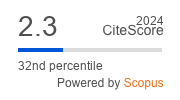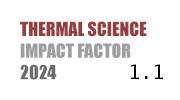ABSTRACT
Pressurized oxy-combustion is a promising technology that can significantly re-duce the energy penalty associated with first generation oxy-combustion for CO2 capture in coal-fired power plants. However, higher pressure enhances the production of strong acid gases, including NO2 and SO3, aggravating the corrosion threat during flue gas re-circulation. In the flame region, high temperature NOx exists mainly as NO, while conversion from NO to NO2 happened in post-flame region. In this study, the conversion of NO → NO2 has been kinetically evaluated under representative post-flame conditions of pressurized oxy-combustion after validating the mechanism (80 species and 464 reactions), which includes nitrogen and sulfur chemistry based on GRI-MECH 3.0. The effects of residence time, temperature, pressure, major species (O2/H2O), and minor or trace species (CO/SOx) on NO2 formation are studied. The calculation results show that when pressure is increased from 1 to 15 bar, NO2 is increased from 1 to 60 ppm, and the acid dew point increases by over 80°C. Higher pressure and temperature greatly reduce the time required to reach equilibrium. With increasing pressure and decreasing temperature, O plays a much more important role than HO2 in the oxidation of NO. A higher water vapor content accelerates NO2 formation in all cases by providing more O and HO2 radicals. The addition of CO or SO2 also promotes the formation of NO2. The NO2 formation in a pressurized oxy-combustion furnace can be over 10 times that of an atmospheric air-combustion furnace.
KEYWORDS
PAPER SUBMITTED: 2020-04-15
PAPER REVISED: 2020-07-31
PAPER ACCEPTED: 2020-08-02
PUBLISHED ONLINE: 2020-09-06
THERMAL SCIENCE YEAR
2021, VOLUME
25, ISSUE
Issue 4, PAGES [2609 - 2620]
- Axelbaum, R. L., et al., Advances in Pressurized Oxy-Combustion for Carbon Capture, CornerStone, 4. (2016), 2, pp. 52-56
- Gopan, A., et al., Process Design and Performance Analysis of a Staged, Pressurized Oxy-Combustion (SPOC) Power Plant for Carbon Capture, Applied Energy, 125 (2014), July, pp. 179-188
- Gopan, A., et al., Effect of Operating Pressure and Fuel Moisture on Net Plant Efficiency of a Staged, Pressurized Oxy-Combustion Power Plant, International Journal of Greenhouse Gas Control, 39 (2015), Aug., pp. 390-396
- Murciano, L. T., et al., Sour Compression Process for the Removal of SOx and NOx from OxyfuelDerived CO2, Energy Procedia, 4 (2011), Dec., pp. 908-916
- Ting, T., et al., Laboratory Investigation of High Pressure NO oxidation to NO2 and Capture with Liquid and Gaseous Water Under Oxy-Fuel CO2 Compression Conditions, International Journal of Greenhouse Gas Control, 18 (2013), Oct., pp. 15-22
- Normann, F., et al., Nitrogen and Sulphur Chemistry in Pressurised Flue Gas Systems: A Comparison of Modelling and Experiments, International Journal of Greenhouse Gas Control, 12 (2013), Jan., pp. 26-34
- Morrison, M., et al., Rate and Mechanism of Gas-Phase Oxidation of Parts-Per-Million Concentrations of Nitric Oxide, Industrial & Engineering Chemistry Fundamentals, 5 (1966), 2, pp. 175-181
- Atkinson, R., et al., Evaluated Kinetic and Photochemical Data for Atmospheric Chemistry: Part 1-Gas Phase Reactions of Ox, HOx, NOx, and SOx species, Atmospheric Chemistry and Physics Discussions, 3 (2003), 6, pp. 6179-6699
- Greig, J. P., Hall, Thermal Oxidation of Nitric Oxide at Low Concentrations, Transactions of the Faraday Society, 63 (1967), pp. 655-661
- Hori, M., et al., An Experimental and Kinetic Calculation of the Promotion Effect of Hydrocarbons on the NO-NO2 Conversion in a Flow Reactor, Symposium (International) on Combustion, Elsevier, 27 (1998), 1, pp. 389-396
- Rasmussen, C. L., et al., Sensitizing Effects of NOx on CH4 Oxidation at High Pressure, Combustion and Flame, 154 (2008), 3, pp. 529-545
- Glarborg, P., et al., Interactions of CO, NOx and H2O Under Post-Flame Conditions, Combustion science and technology, 110 (1995), 1, pp. 461-485
- Rasmussen, C. L., et al., Experimental Measurements and Kinetic Modeling of CO/H2/O2/NOx Conversion at High Pressure, International Journal of Chemical Kinetics, 40 (2008), 8, pp. 454-480
- Mueller, M., et al., Flow Reactor Studies and Kinetic Modeling of the H2/O2/NOx and CO/H2O/O2/NOx Reactions, International Journal of Chemical Kinetics, 31 (1999), 10, pp. 705-724
- Gersen, S., et al., Ignition-Promoting Effect of NO2 on Methane, Ethane and Methane/Ethane Mixtures in a Rapid Compression Machine, Proceedings of the Combustion Institute, 33 (2011), 1, pp. 433-440
- Krzywanski, J. W., Nowak, Neurocomputing Approach for the Prediction of NOx Emissions from CFBC in Air-Fired and Oxygen-Enriched Atmospheres, Journal of Power Technologies, 97 (2017), 2, pp. 75-84
- Liu, H., Gibbs, B. M., The Influence of Limestone Addition at Different Positions on Gaseous Emissions from a Coal-Fired Circulating Fluidized Bed Combustor, Fuel, 77 (1998), 14, pp. 1569-1577
- Mueller, M., et al., Kinetic Modeling of the CO/H2O/O2/NO/SO2 System: Implications for High‐Pressure Fall‐Off in the SO2 + O (+M) = SO3 (+M) Reaction, International Journal of Chemical Kinetics, 32. (2000), 6, pp. 317-339
- Pang, L., et al., Experimental Investigation of Oxy-coal Combustion in a 15 kWth Pressurized Fluidized Bed Combustor, Energy and Fuels, 33 (2019), 3, pp. 1694-1703
- Duan, Y., et al., Observation of Simultaneously Low CO, NOx, and SO2 Emission During Oxycoal Combustion in a Pressurized Fluidized Bed, Fuel, 242 (2019), Apr., pp. 374-381
- Dayma, G. P., Dagaut, Effects of Air Contamination on the Combustion of Hydrogen effect of NO and NO2 Addition on Hydrogen Ignition and Oxidation Kinetics, Combustion science and technology, 178 (2006), 10-11, pp. 1999-2024
- Dagaut, P., et al., A Jet-Stirred Reactor for Kinetic Studies of Homogeneous Gas-Phase Reactions at Pressures Up to Ten Atmospheres (≈1 MPa), Journal of Physics E Scientific Instruments, 19 (1986), 3, p. 207
- Allen, M. T., et al., The Decomposition of Nitrous Oxide at 1.5 P 10.5 atm and 1103 T 1173 K, International Journal of Chemical Kinetics, 27 (1995), 9, pp. 883-909
- Smith, G. P., et al., GRI-Mech 3.0, 1999, URL http://www. me. berkeley. edu/gri_mech., 2011
- Glarborg, P., et al., Impact of SO2 and NO on CO Oxidation Under Post‐Flame Conditions, International Journal of Chemical Kinetics, 28 (1996), 10, pp. 773-790
- Kee, R. J., et al., CHEMKIN-III: A FORTRAN Chemical Kinetics Package for the Analysis of GasPhase Chemical and Plasma Kinetics, Report, SAND 96-8216, UNT, USA, 1996
- Wang, X., et al., Kinetic Investigation of the SO2 Influence on NO Reduction Processes During Methane Reburning, Asia‐Pacific Journal of Chemical Engineering, 5 (2010), 6, pp. 902-908
- Bendtsen, A. B., et al., Visualization Methods in Analysis of Detailed Chemical Kinetics Modelling, Computers & Chemistry, 25 (2001), 2, pp. 161-170
- Wang, X., et al., Synergistic SOx/NOx Chemistry Leading to Enhanced SO3 and NO2 Formation During Pressurized Oxy-Combustion, Reaction Kinetics Mechanisms and Catalysis, 123 (2018), 2, pp. 313-322
- Senior, C. L., et al., Gas-Phase Transformations of Mercury in Coal-Fired Power Plants, Fuel Processing Technology, 63 (2000), 2, pp. 197-213
- Tan, Y., et al., Combustion Characteristics of Coal in a Mixture of Oxygen and Recycled Flue Gas, Fuel, 85 (2006), 4, pp. 507-512
- Gao, Z., et al., Heat Transfer Characteristics of Boiler Convective Heating Surface Under Pressurized Oxygen-fuel Combustion Conditions [J], Proceedings of the CSEE, 32 (2012), 23, pp.1-8

